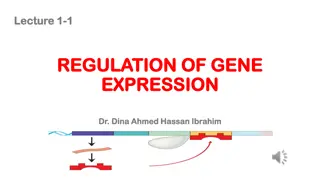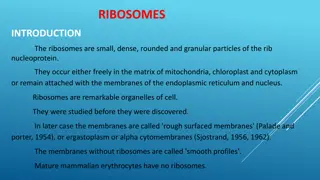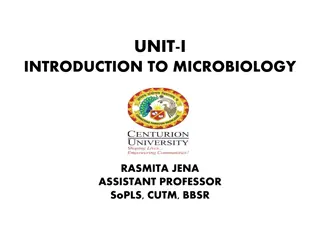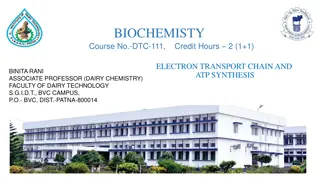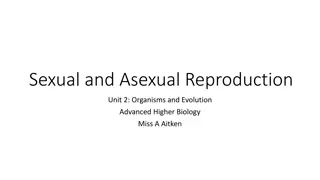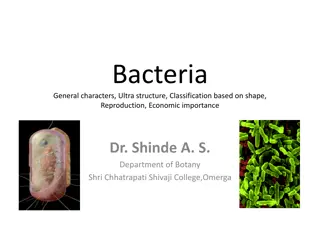Understanding Gene Expression Regulation in Prokaryotes and Eukaryotes
Gene expression is a crucial process that leads to the production of functional gene products like RNA and proteins. This article explores the regulation of gene expression in both prokaryotes and eukaryotes, covering the importance of regulating gene expression, types of regulation elements, specif
5 views • 22 slides
Understanding Levels of Organization in Living Organisms
Explore the levels of organization in living organisms, from atoms to cells, and the differences between unicellular and multicellular organisms. Learn about prokaryotes, eukaryotes, cell differentiation, chromosomes, and the importance of stem cells in development and repair.
0 views • 17 slides
Understanding Bacterial Photosynthesis: Types and Processes
Photosynthesis is the conversion of light energy into chemical energy, crucial for growth and production of ATP. Prokaryotes such as cyanobacteria, purple and green bacteria, and halobacteria demonstrate different forms of photosynthesis. Oxygenic photosynthesis, found in cyanobacteria, releases oxy
2 views • 20 slides
Understanding DNA Replication in Prokaryotes for B.Sc. Botany Hons. Students
Study material on DNA replication in prokaryotes focusing on key concepts like semiconservative mode of replication, involvement of enzymes, different models for understanding replication, and the bidirectional nature of DNA replication in prokaryotes. The material covers the process steps including
0 views • 33 slides
Exploring Motility in Prokaryotes: Flagellar, Spirochaetial, and Gliding Movements
Delve into the fascinating world of bacterial motility through three types of movements in prokaryotes: flagellar movement driven by rotating flagella, spirochaetial movement with flexible axial fibrils, and gliding movement observed in certain bacteria on solid surfaces. Additionally, discover how
1 views • 14 slides
Understanding Ribosomes: Structure and Function
Ribosomes, essential organelles in cells, exist in two types - 70s and 80s. They play a crucial role in protein synthesis. Structurally, ribosomes are composed of two subunits held together by Mg++ ions. The ultrastructure of ribosomes, particularly in prokaryotes, is intricate, with RNA and protein
0 views • 18 slides
Understanding Microbiology: An Introduction to the World of Microorganisms
Microbiology, the study of microorganisms, encompasses the history, branches, classification, and importance of microbes. From prokaryotes to eukaryotes, this field delves into the realm of tiny life forms invisible to the naked eye. Explore the rich history of microbiology, its branches, and the wi
2 views • 35 slides
Biology Revision with AQA Trilogy: Cell Biology and Organism Organization
In this biology revision session for AQA Trilogy, we delve into topics like cell biology, organism organization, diffusion, osmosis, active transport, enzymes, and more. Explore the differences between prokaryotes and eukaryotes, understand cell specialization, and learn about key processes like mit
0 views • 8 slides
Understanding Unicellular and Multicellular Organisms in Biology
Explore the basic differences between unicellular and multicellular organisms, including the distinctions between prokaryotes and eukaryotes. Unicellular organisms, such as bacteria and amoeba, consist of a single cell and are often microscopic. Examples of both prokaryotic and eukaryotic unicellula
0 views • 10 slides
Overview of Cell Division in Prokaryotes and Eukaryotic Cells
Cell division plays a crucial role in the growth and reproduction of all organisms. In prokaryotic cells, binary fission is the primary mode of division, while eukaryotic cells undergo a more complex process involving cell growth, DNA replication, chromosome distribution, and cytokinesis. The cell c
0 views • 10 slides
Understanding Electron Transport Chain and ATP Synthesis in Biochemistry
This course delves into the intricacies of electron transport and oxidative phosphorylation in biochemistry, elucidating how NADH and FADH2 are re-oxidized to generate ATP in eukaryotes and prokaryotes. It explores redox potential, oxidation-reduction reactions, and the role of standard redox potent
0 views • 20 slides
Exploring Molecular Biology and Cell Science
Molecular biology delves into the study of biology at the molecular level, focusing on gene structure and functions to comprehend hereditary traits, genetic variation, and gene expression patterns. Cells, the fundamental units of life, vary in shape and function but share basic structures. The Three
0 views • 31 slides
Understanding Reproduction: Sexual vs Asexual and the Paradox of Sex
Explore the benefits and drawbacks of sexual and asexual reproduction in organisms, why both forms exist, and the paradox of sex. While asexual reproduction offers efficiency and simplicity, sexual reproduction introduces genetic diversity and complexity. Discover how different species, including pr
0 views • 8 slides
Understanding Bacteria: General Characteristics and Economic Importance
Bacteria are ubiquitous microorganisms found in various environments, with some living as commensals or symbionts while others causing diseases. They are characterized by their small size, absence of a nucleus, and diverse classifications such as prokaryotes, eukaryotes, cyanobacteria, and archaebac
0 views • 15 slides
Understanding Antifungal Inhibitors and Drugs
In this detailed overview, we explore antifungal inhibitors and drugs, including their mechanisms of action, impact on eukaryotes and prokaryotes, common agents affecting fungal sterols and cell walls, as well as synthetic antifungals. From polyenes like nystatin to azoles such as voriconazole, this
0 views • 12 slides
Exploring Prokaryotes and Earth's Ancient Life Forms
Uncover the fascinating world of prokaryotes - the earliest inhabitants of Earth dating back billions of years. From microbial mats to stromatolites, delve into the history of life on our planet and the evolution of the atmosphere. Discover how cyanobacteria played a pivotal role in oxygenating the
0 views • 31 slides
